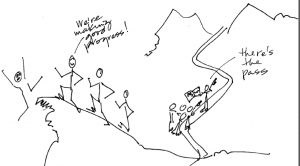A Cautionary Tale: When Good Communication Goes Off Track
Good communication is important on the smallest of projects. My co-author Jim Ewing and I were in the middle of a very small project: designing the cover of the comedic thriller we wrote. Things were chugging along when suddenly design elements were in a big messy pile like the catch of the day. As our protagonist, Juice Verrone, would say: “Is this some kind of a joke?” Sadly, no. Our project was derailed (temporarily) by poor communication.
Here’s how it all started. Jim and I decided to use a design competition web site, 99designs.com. The project started down a familiar path. When Jim created the competition, he posted information that sounds a lot like a project summary: a book cover design that would work in color and grayscale for both print and eBook (the goal and scope rolled into one), the price level (the budget,) a description of the novel’s plot, ideas we had, a sketch I had drawn (requirements of sorts).
The design competition has a process, which we followed. During the first round, people submitted designs. Jim and I discussed the entries, provided feedback, and received revised designs. We rinsed and repeated over the several days of round one. It was all very agile. Round two was similar, although our feedback became more specific and detailed.
Several of the designers were from other countries. This international competition was a crash course in communication issues due to cultural, geographical, publishing, and other differences. Who knew book spines run in different directions in different countries? It was also interesting to see how our novel got renamed by non-native American English speakers. The book title, “Fresh Squeezed,” morphed into the grammatically correct Freshly Squeezed on a few entries.
We picked a winner and explained that the real work was now beginning. We were going to work with the winner’s basic design and iterate to the final cover. This is when things got shaky. We made specific requests but the results that came back seemed to be further off-track. Colors that had been correct in previous iterations were suddenly wildly off base.
Jim was the point person so he tried reducing the number of changes in each iteration. He asked the designer to go back to an earlier revision that had the colors we wanted. But the results were still off.
Jim and I were confused and frustrated. Then I thought of a technique that Stephen Covey recommends. Instead of descending deeper into micro-management, I suggested he say “Help me to understand why we are having problems with the colors.” Turns out that the three-dimensional fish on the cover was created in one program. Then the colors and other effects were added in a second program followed by some clean-up steps. And finally that polished image goes into the book cover file. Every time we asked for a change to the fish, she had to jump through all those hoops (with the potential for glitches.) No surprise, those steps took her quite a bit of time–for every individual request we made.
 Understanding her process clarified the situation and led the way to a more effective change management approach. We worked on the fish without color effects to get its shape and facial expression right. Then, moved on to applying the color — once. With the fish complete, we could move on to the other elements of the cover. Finally, when all the elements were finalized, she laid them out on the book cover.
Understanding her process clarified the situation and led the way to a more effective change management approach. We worked on the fish without color effects to get its shape and facial expression right. Then, moved on to applying the color — once. With the fish complete, we could move on to the other elements of the cover. Finally, when all the elements were finalized, she laid them out on the book cover.
All along, we felt like we were communicating. But messages weren’t getting across. When we went from brainstorming into “production,” we were really moving from an early project phase (completed prototype or proof of concept) into project execution. We should have taken some time to plan how we were going to work, ask the designer questions about her process and how we could work with her most effectively.
The moral of this story: communication is crucial and requires careful planning, followed by care and feeding–even in small projects like our book cover. Remote or multicultural (or multi-anything) teams complicate the process. Finally, we can learn a lot about managing big projects from small projects we perform every day, which brings us back around to the importance of lessons learned!

